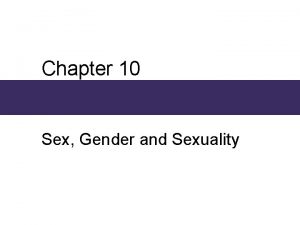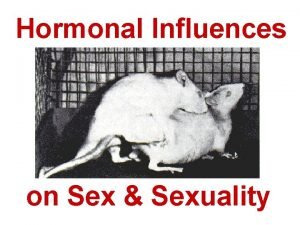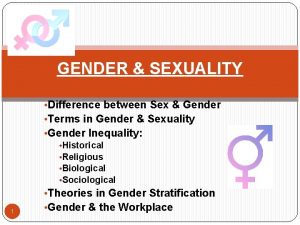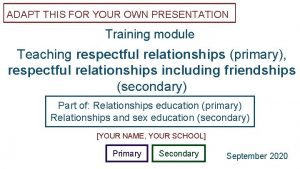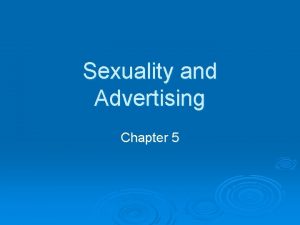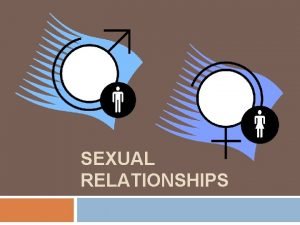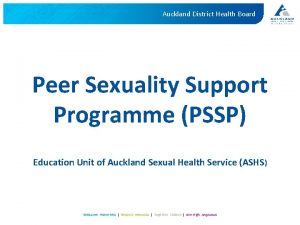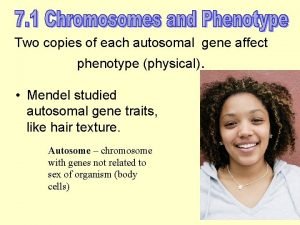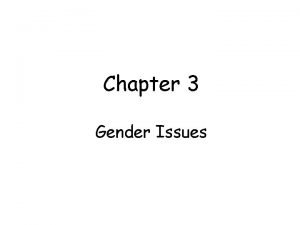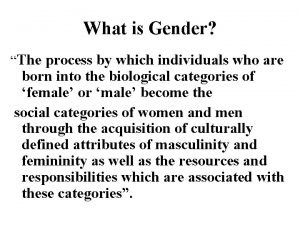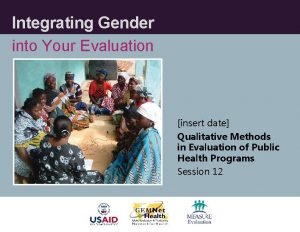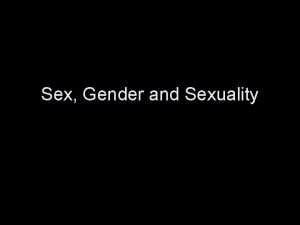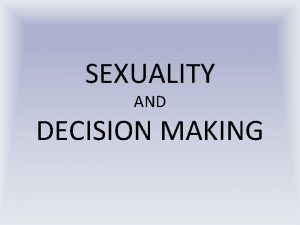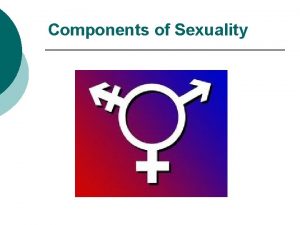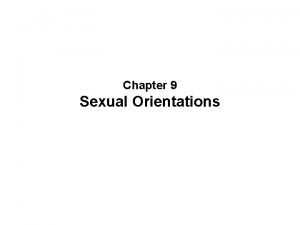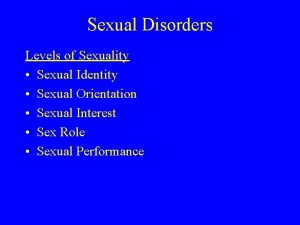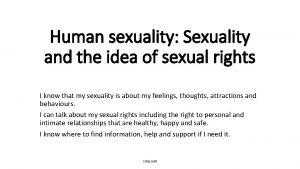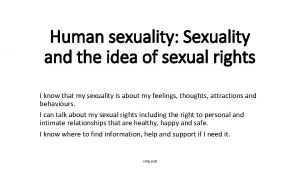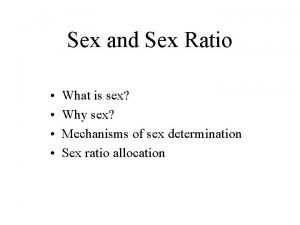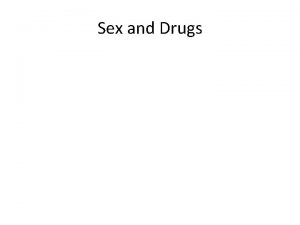Sex sexuality sexual orientation sexual acts and their






































- Slides: 38

Sex, sexuality, sexual orientation, sexual acts and their risks

By differences in sex organs… The female sex organs

The Male sex organs

‘People who have anal sex are essentially people with bad moral characters’.

Sex and sexual preference n n Sex is a natural reward and fulfils more purposes than just reproduction in human lives Among other purposes sex is also for pleasure There are various sexual acts and people have their own preferences Preferences maybe guided by gender and type of partners selected, which again is based on the sexuality of the individual

Sexuality n n n Sexuality is the expression of one’s sexual feelings-through words and actions which may or may not be overtly related to sex. It is often guided by cultural norms varying from one community to another and changing with gender, age and socio-economic position of the individual. The degree of expression is often controlled by the degree of permissiveness allowed by the society.

Sexuality… n n n Sexuality is the result of interplay of biological (genetic and hormonal), psychological, socioeconomic, cultural, ethical and religious/spiritual factors. It encompasses sex, gender, sexual and gender identity, and reproduction and all related aspects of human life. Sexuality is expressed through sexual orientation, eroticism, emotional attachment/love and various other behaviours and practices that go beyond the mere sexual acts.

Sexual orientation n n Sexual orientation is individual’s personal eroticism and/or emotional attachment with reference to the sex and gender of the partner involved in sexual activity. Sexual orientation guides the preference of sex partner (male, female, transgender), type of sexual act (peno-oral, peno-vaginal etc. ).

Sexual orientation. . n n n Heterosexuals -prefer opposite sex (male – female), Homosexuals -attracted to the same sex (male-male or female-female) Bisexuals have sex with both- same sex as well as from the opposite sex

Important for the counsellor ü ü For a service provider importance of the act lies in the degree of risk it poses for the people involved rather than the cause of choice Being judgemental will alienate the client and pose barriers to service provision

Sexual exposure routes n n n Receptive anal Receptive Vaginal Insertive anal Insertive vaginal Receptive oral Insertive oral


Sexual risks

Sexual risks Personal high risks Partner’s high risks Sex, not protected with condom History of injecting drug use Anal sex History of multiple sex partner Multiple sex partner History of sex with HRG Use of alcohol or drugs before sex Using alcohol or drugs before sex Sex with HRG Infected with HIV, Hep-B, C or with history of STI Situational/positional risk Practicing -sex work/MSM/IDU Surviving-sexual abuse/rape Population in prison

Sexual risks among IDUs n n n Drugs ‘cloud’ the brain affecting thoughts and actions Drugs lower their inhibition leading to ‘loss of judgement’ resulting in greater risk taking Drug use affect power of working with the hand fingers (effect of drugs on nervous system) – making it difficult for them to wear and take off a condom correctly Drug use often leads to disruption of relationship and broken family leading sex with casual and/or commercial partners IDU (especially females) may be compromised to sell sex to procure drugs

Sexual risk assessment n n Sexual risk assessment must be done at initiation of services and also in case the client: Has been diagnosed with STIs/HIV, Hep-B/C Reports/complains symptoms of STIs Needs to be screened for STIs Needs to be referred for Integrated Counselling & Testing Centres (ICTC)

Objectives of sexual risk assessment n n n To make an accurate and efficient assessment of the sex related risks faced by the client To assess the client’s risk of transmitting and contracting STIs To help the client recognize the behaviour/s as harmful to self and partner To help the client understand that alternatives are available To ascertain the course of further action and requisite services To help the client seek treatment and allied services needed for changing the high risk behaviour.

Assessment should cover. . . n n n Sexually active or not (in the last one year)? Number of sex partners (in the last one year): Regular (spouse/girlfriend/boyfriend) Non regular (other than spouse/girlfriend) Commercial (paid for sex) Condom use with: Regular (spouse/girlfriend/boyfriend)-how often and last time Non- regular (other than spouse/girlfriend)- how often and last time Commercial (paid for sex)- how often and last time History of STIs-treated, untreated? Signs and symptoms of STIs present?

Assessment. . . n n n Drug/alcohol use before sex. History of sex with a male. (In case of male client) In case of history of male to male sex: q q q Nos. of male partners Type of act Frequency/consistency of condom use.

Role play • 17 yrs old male IDU

Sexual risk reduction counselling n n n n Share the level of risk of the client based on his/her current sexual practices Educate client on the risks and their complications, both current and future Explore client’s feelings about the risk/s Refer for STI screening, if the client reports/complains signs and symptoms of STIs of self or the partner Assess level of risk perception by the client Educate the client in case of incorrect perception and/or misconceptions, if any Check for the client’s level of concern and actions already being taken by him/her, if any

Sexual risk reduction n n n n Appreciate efforts already in place, if any Correct the ideas and practices that will not help in the risk reduction Educate the client on alternatives that may help in reducing risks Help the client set achievable goals and plan practicable steps towards it Educate on importance of condom use, demonstrate correct steps for using and also provide condoms Discuss potential barriers to the risk reduction strategy planned by the client and possible support Agree on the final strategy and timeline Endorse a follow up plan

Role paly • 25 yrs old female IDU, male partner also IDU

Hierarchy of sexual risk Sexual abstinence Non penetrative sex Sex with one mutually tested and trusted partner Sex with consistent and correct condom use Oral sex Vaginal sex Anal sex

Follow up visit n n n n n Check for adherence to the strategy/plan Appreciate efforts made –highlight achievements Explore reasons for failure or inaction, if any Explore alternative approaches and other options Suggest corrections, if any Help redesign the strategy with the client Discuss potential barriers and possible supports Motivate to seek Voluntary Counselling & Testing Agree on the final strategy and timeline Endorse a follow up plan

Signs and Symptoms of STIs (the syndromic guideline) In males In females • Urethral discharge (Discharge or pus from the penis)/Burning or pain during urination/frequent urination • Genital itching • Swelling in groin/scrotal swelling • Blisters or ulcers on the genitals, anus, mouth, lips • Itching or tingling in genital area • Ano-rectal discharge • Warts on genitals, anus or surrounding area • Unusual /foul smelling vaginal discharge • Genital itching • Abnormal and /or heavy vaginal bleeding • Pain during sexual intercourse • Lower abdominal pain (pain below the belly button, pelvic pain) • Blisters/ulcers on the genitals, anus or surrounding area, mouth, lips

Objective of STI counselling To help the client: n seek and complete treatment, if infected with STIs n being screened for STIs, if showing signs and symptoms of STIs or with history of unprotected sex or sex with HRG and receive subsequent services as required n complete the treatment with partner identification and screening/treatment of partner n reduce high risk sexual practices that may infect/re infect the client.

Motivation for screening n n n n n The client will need to be prepared and motivated for screening before the clinical examination of the genital area and insertion of equipment into the vagina and anus. The steps will include: Sharing the level of risk of the client Educate client on STIs their complications Explore client’s feelings about the risk/s Educate the client on the need for screening Explain the components of STI treatment Help to evaluate the pros and cons of seeking treatment Refer for STI screening Endorse a follow up plan

STI counselling n n n n n Educate on the diagnosis based on the syndromic approach, cause of infection and the treatment Help the client take the medicines Educate on importance of completing the medication Explain the need for contacting the doctor, incase of side effects Educate the client on impact of not completing treatment Explain interaction of the medicines with alcohol. Help plan strategies to avoid alcohol use Explain the importance of condom use Demonstrate proper condom use and provide condoms.

STI counselling. . n n Educate on the importance of partner notification and treatment of partner Explore alternative sexual practices for risk reductions Reinforce importance of treatment completion Endorse plan for follow up

STI treatment component Screening for STI Complete medication All sex protected with condom Follow up Partner/s notification Treatment of partner/s Treatment adherence by partner/s Follow up including check up by partner/s Continued safer sexual practices

STIs and IDUs n n n n IDUs equally vulnerable to transmission of STIs as any HRG Drugs injected are often have analgesic properties they also reduce pains of STIs IDUs often need antibiotics for their abscesses; these may hide ulceration or partially treat STIs IDUs often inject in groin or penis; genital ulcers may be misinterpreted as ulcers caused by injections Signs/symptoms may be attributed to injections and drugs used missing out STI related symptoms Among IDUs, swelling of the lymph nodes in the groins (femoral lymphadenopathy) may be caused due to infections from blisters/abscesses in the foot or un-hygienic living conditions rather than STIs. Stigma attached to STIs generally, sometimes may also bar the IDUs from reporting signs and symptoms

Condoms

Condom n n n Using condom is the most reliable mode of prevention of STI HIV There are both male and female condoms Male condom is put on the erect penis Female condom is inserted into the vagina Both male and female condom should be put on/inserted before any sexual contact is made Both male and female condoms act as a barriers, preventing the contact between infective secretions (semen or genital fluids, vaginal fluids) and the mucus membrane of the vagina, anus, glans, penis or urethra

Uses of condom n n n Prevents unwanted pregnancy Protects self and partner against STI, HIV, Hep-B, C Enhance the pleasure (by delaying ejaculation) associated with sex

Reasons for not using condoms n n Condoms may not be easily available or accessible Stigma attached to condom use Lack of knowledge on the correct use of condoms Existing myths and misconceptions related to condoms

Myths about condoms n n n n n Using condoms during sex is irritating Condom may tear during intercourse Condom is sticky and oily Condom reduces sexual pleasure Women do not like it Loss of erection Not ‘manly’ Condoms are reusable Two condoms are better protection than one

Counsellor’s role in condom promotion n n n n Explain the need for correct and consistent use of condoms as a part of treatment of STI and protection from STI, HIV, Hep-B & C infections and unwanted pregnancy Educate on correct use of condom through demonstration using penis and vagina models Make sure condoms are readily available in the clinic and accessible to people who need them Keep the condoms in a visible transparent box Distribute free condoms to clients visiting clinics Ensure those who are involved in sex work have an adequate stock of condoms to protect themselves Display and distribute information on STI and HIV/AIDS and on condom use Ensure a minimal 3 months supply of condoms
 Sex sex sex
Sex sex sex Sex in the greenhouse
Sex in the greenhouse Sex sex sex
Sex sex sex Sex sex sex
Sex sex sex Secondary sexual characters
Secondary sexual characters Chapter 10 sex gender and sexuality
Chapter 10 sex gender and sexuality Androgen insensitivity
Androgen insensitivity Sex gender and sexuality
Sex gender and sexuality Linkage
Linkage Heterogametic
Heterogametic Sex determination and sex linkage
Sex determination and sex linkage Once a sex offender always a sex offender
Once a sex offender always a sex offender Sexual motivation ap psychology
Sexual motivation ap psychology Examples of companies following ethnocentric approach
Examples of companies following ethnocentric approach Pretest growth development and sexuality
Pretest growth development and sexuality Sexual orientation gender identity
Sexual orientation gender identity Sexual orientation stereotypes
Sexual orientation stereotypes Different modifiers of human acts
Different modifiers of human acts Sexuality in advertising
Sexuality in advertising Four intertwining strands of sexuality
Four intertwining strands of sexuality Circle of sexuality
Circle of sexuality Definition of sexuality
Definition of sexuality Types of sexual relationships
Types of sexual relationships Which illustrates an emotional aspect of teen sexuality?
Which illustrates an emotional aspect of teen sexuality? Peer sexuality support programme
Peer sexuality support programme Base of uterus
Base of uterus Sexuality spectrum
Sexuality spectrum Two households, both alike in dignity.
Two households, both alike in dignity. Autosomal gene
Autosomal gene Sex male and female
Sex male and female Sex and the city troy
Sex and the city troy Autosomes and sex chromosomes
Autosomes and sex chromosomes Sex intercourse meaning and examples
Sex intercourse meaning and examples Sex and cholesterol
Sex and cholesterol Difference between gender and sex
Difference between gender and sex Samenvatting noughts and crosses
Samenvatting noughts and crosses Difference between gender and sex
Difference between gender and sex Sex cat
Sex cat Difference between gender and sex
Difference between gender and sex





